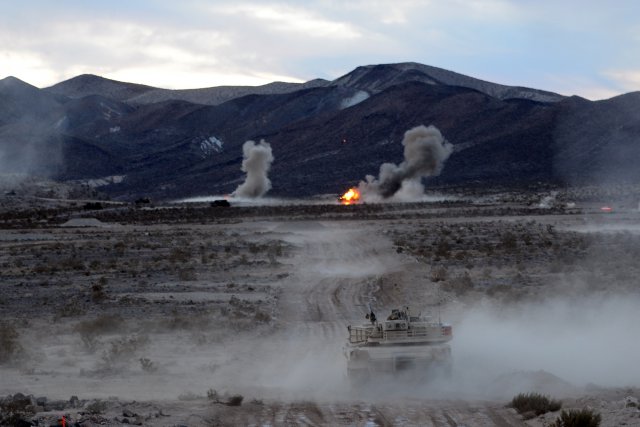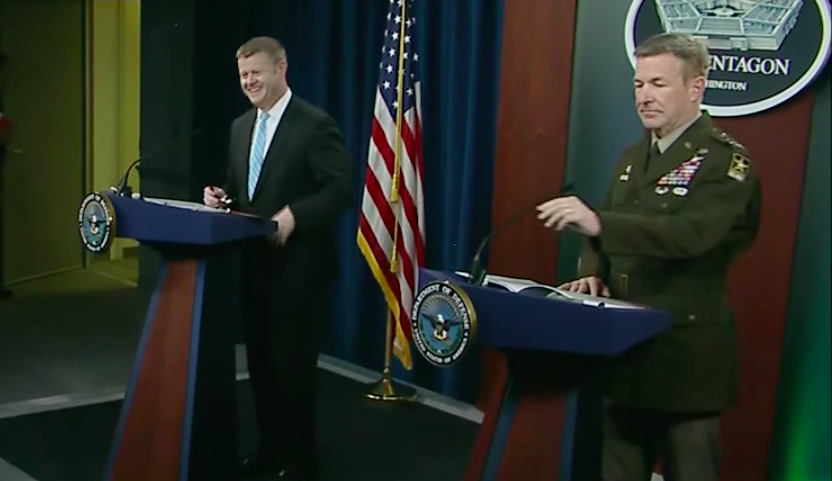
M1 tank at the National Training Center at Fort Irwin, California.
WASHINGTON: “Just because someone can carry the weight, doesn’t mean that it isn’t heavy,” Army Secretary Ryan McCarthy said at the AUSA 2020 conference today. That’s why, this morning, McCarthy, Army Chief of Staff Gen. James McConville, and Sergeant Major of the Army Michael Grinston outlined a new effort to shorten deployments, eliminate some training exercises and focus on team-building from the bottom up.
“We’ve surveyed the force [and] the optempo is still extremely high, even as the numbers of forces in combat has come down,” McConville told reporters. “We’re taking a look at the rotational deployments [and] how we are training.”

Army Secretary Ryan McCarthy (left) and Chief of Staff Gen. James McConville (right) give a briefing on COVID-19 response in April.
Commanders will now have more flexibility to determine what training their troops need, without being as beholden to Army-wide mandates. “We will focus our training on the basics of individual, squad, platoon, and company-level training and key leader training,” McCarthy told the conference, “while reducing the requirement to conduct brigade and battalion live-fire exercises.”
It’s unclear how the new focus on small units will work with the Army’s move to emphasize great-power conflict. A conventional war with Russia or China would require large formations – divisions, corps, and theater armies – to work together on a much grander scale than the highly localized guerrilla warfare of Afghanistan and Iraq. But Gen. McConville expressed confidence that units could quickly rise to the challenge.
“A great example was the 1/34th ABCT [Armored Brigade Combat Team] out of Minnesota,” McConville said. As a National Guard unit, the 1/34th had been busy supporting civilian authorities against COVID and domestic unrest. That disrupted its normal train-up for full-brigade wargames at the National Training Center in Fort Irwin.
Instead of getting to rehearse the whole brigade working together before going to NTC, “they came in trained up to the platoon level,” McConville said. “They just didn’t have time to do much after that” – that is, they largely skipped the normal company, battalion, and brigade work-ups – “but because they had a strong foundation, they were able to really do a great job out there, and they quickly picked up on those other skill sets.
“Our Combat Training Centers are the gold standard for preparing our organizations for large-scale ground combat operations, [and] there’s no intent to reduce Combat Training Center rotations for units,” McConville emphasized. [UPDATE: The Army will have fewer CTC rotations next year than it did before COVID, however]. “That’s not what we’re discussing. We’re discussing what the prerequisites are to actually go to a Combat Training Center” – such as the large-scale live-fire exercises mentioned by Sec. McCarthy.
Instead, “some of the higher-level training, you may be able to do in simulation,” McConville said. (The Army’s investing heavily in new training simulations, although Congress has expressed skepticism of the new virtual and augmented reality tech). Other large-scale training events could be held after the CTC rotation, he said, even while the unit is deployed abroad.
There’s no intention of making large-scale training for battalions or brigades less rigorous, McConville said: “The intent is to give more time back to our sergeants at the lower levels, so they have chances to build cohesive teams of highly trained and fit soldiers at the squad, platoon, and company level that is the foundation or army.”
Even large-scale exercises at the National Training Centers require that foundation of individual readiness, added Sergeant Major of the Army Grinston. “I still think it’s extremely valuable for individual soldier readiness to deploy to a JRTC [Joint Readiness Training Center, Fort Polk, La.] or a National Training Center or even over to Hohenfels [in Germany],” he said, because you have to make sure you’ve got all your basics right: “How do you pack your bags? How do you make sure all your family care plans are in order?”
At the same time, the Army is keenly aware its troops are stressed and hope to ease the burden of training – and, if possible, to reduce deployments overseas at well.
“We… are reducing the demands of rotational deployments,” McCarthy said.
But how? That’s not entirely up to the Army, since the joint Combatant Commanders around the world are the ones who put in requests for forces.
“We’re working with COCOM commanders to see how we can accomplish the mission in innovative ways,” McConville said.
The implication here is that “innovative” means “with fewer people.” But adversaries around the world will have a vote when it comes to how many troops the US actually needs abroad.






















